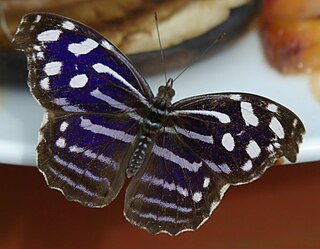
The Satyrini is one of the tribes of the subfamily Satyrinae. It includes about 2200 species and is therefore the largest tribe in the subfamily which comprises 2500 species.

Biblidinae is a subfamily of nymphalid butterflies that includes the tropical brushfoots. This subfamily was sometimes merged within the Limenitidinae, but they are now recognized as quite distinct lineages. In older literature, this subfamily is sometimes called Eurytelinae.

Catonephele is a nymphalid butterfly genus found in Mexico, Central America, South America, and the West Indies.

Hestina is a genus of butterflies in the family Nymphalidae subfamily Apaturinae. The genus is found in the East Palearctic and Southeast Asia.

Callicore is a genus of nymphalid butterfly found in the Neotropical realm. This genus, like some related ones, was formerly lumped together as the paraphyletic Catagramma assemblage.

Emesis is a Neotropical genus of butterflies.

Lyropteryx is a genus of butterflies of the family Riodinidae. Species of this genus are widespread in the tropical areas of the South America.

Catoblepia is a genus of Neotropical butterflies in the family Nymphalidae. Larvae feed on bananas and adults feed on rotting fruit.

Dynamine is a genus of nymphalid butterflies found in South America.

Taenaris is a genus of butterflies in the family Nymphalidae, subfamily Amathusiinae, that distributed throughout Australasia with a majority of species being located on the island of New Guinea. They are commonly known as the owl butterflies.

Dynastor is a genus of butterflies in the family Nymphalidae. Members of the genus can be found from Mexico to Central and South America.

Opsiphanes is a genus of butterflies of the family Nymphalidae found from Mexico to South America.

Dasyophthalma rusina is a butterfly of the family Nymphalidae. It is found in Brazil, from Bahia to Santa Catarina. The habitat consists of high altitude areas.

Dasyophthalma creusa is a butterfly of the family Nymphalidae. It is found in Brazil, from Bahia to Rio Grande do Sul.

Melanis is a genus in the butterfly family Riodinidae present in the Neotropical realm.

Euselasia is a genus of butterflies in the family Riodinidae. They are present only in the Neotropical realm. The genus was erected by Jacob Hübner in 1819.

Symmachia is a genus in the butterfly family Riodinidae present only in the Neotropical realm.

















